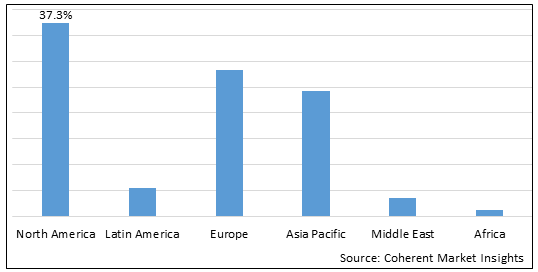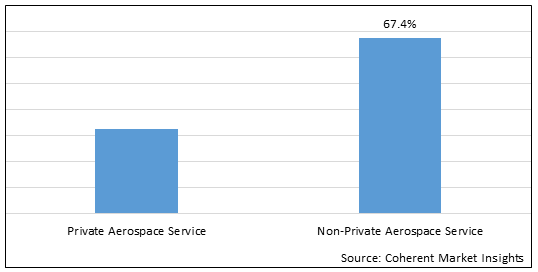Global Space Medicine Market is estimated to be valued at USD 948.7 Mn in 2025 and is expected to reach USD 1,969.7 Mn in 2032, exhibiting a compound annual growth rate (CAGR) of 11% from 2025 to 2032.
Space medicine is a relatively new field that aims to address the complex medical needs of human spaceflight.
Global Space Medicine Market Regional Insights:
- North America is expected to dominate the global space medicine market over the forecast period owing to the presence of major players and advanced healthcare infrastructure in the region. The region is home to key players such as NASA and various space research organizations. It has the largest annual budget allocation for space research and development globally. This has created a sizable market for space medicine technologies and services in the region over the decades. The region also has a highly skilled workforce and world-class universities focusing on aerospace medicine, which boosts industry presence. With numerous government partnerships and contracts for space projects, the demand for space medicine from both public and private organizations is high.
- Europe is expected to be the second largest market for space medicine during the forecast period. Space tourism, satellite-based communication, and others are key factor propelling the market growth in Europe.
- The Asia Pacific is expected to be hold the third-largest market share in the global space medicine market during the forecast period. Countries like China and India have significantly ramped up their national space programs. Both countries now have independent human spaceflight capabilities as well as ambitious plans for lunar and planetary exploration. This is generating a massive need for advancements in space medicine to ensure astronaut health and safety during deep space missions. The lower costs have also attracted private space companies to set up operations in Asia Pacific. Furthermore, growing healthcare sectors and investments in research & development across the region are continuously improving the innovation landscape for space medicine applications. The supportive government policies are further fueling the market opportunities, positioning Asia Pacific as an attractive production and export base. Strong economic growth is also increasing the focus on spin-off benefits of space medicine research for terrestrial healthcare needs.
Figure 1. Global Space Medicine Market Share (%), by Region, 2025

To learn more about this report, Download Free Sample
Global Space Medicine Market- Analyst’s Views:
The space medicine market is poised to grow significantly over the forecast years. Some of the key drivers for market growth are the increasing number of space exploration missions by both government and private space agencies. The commercialization of space is also opening new opportunities for developments in telemedicine, virtual reality based training, and remote surgery technologies for space applications.
North America dominates the market due to high investments by NASA and private space start-ups in the U.S. However, Asia Pacific is expected to emerge as the fastest growing region with countries like China and India rapidly expanding their space exploration programs. New players from Asia Pacific are entering the market with affordable solutions for satellite-based healthcare and space-related medical research. One of the main restraints is the high cost associated with zero-gravity and space environment related R&D. Establishing permanent bases on Moon and Mars will be a huge boon and create sustained demand for advanced life support systems, space agriculture, radiation protection, and autonomous medical equipment. International collaborations for developing harmonized safety standards and protocols can further accelerate growth.
Global Space Medicine Market Drivers:
- Understanding the growing need for space exploration: As human strive to unlock the mysteries of space and push the boundaries of exploration, necessity will drive development of new technologies to ensure astronaut safety. Orbital missions that extend duration spent in low or zero-gravity environments introduce health risks not encountered on Earth. Prolonged periods isolated from medical support infrastructure also creates challenges for diagnosis and treatment of emergencies. Though space agencies take extensive precautions, long-term impacts of factors like cosmic radiation exposure remain uncertain. Advancing biomedical understanding through dedicated research aboard space stations and eventual human settlements on other worlds will be crucial. Growth of the commercial space sector bringing more players into the arena increases importance of mitigating risks to protect investments as well as lives. Ensuring physical and mental well-being of crew members on long haul missions essential not just for safety but also productivity. This growing need to sustain humanity's expansion beyond Earth's bounds will undoubtedly fuel demand for specialized space medicine solutions, technologies and services.
- Space flight safety: Space flight safety has become one of the major concerns for both government and private space agencies across the globe. With more number of manned as well as unmanned space missions planned in the coming years, keeping astronauts and payloads healthy has assumed utmost importance. This has propelled the growth of space medicine which aims to deal with medical problems resulting from being in hostile space environment. Astronauts are susceptible to various medical challenges like decompression sickness, hypoxia, radiation sickness etc. due to hostile conditions of outer space like vacuum, microgravity and exposure to radiations. To address such challenges and ensure health and safety of astronauts, space agencies are focusing on biomedical monitoring, emergency medical support and tele-medicine technologies.
Global Space Medicine Market Opportunities:
- Growing scope in developing countries space programs: The growing scope of developing countries' space programs is indeed a major opportunity for the global space medicine market. Countries like India, China, and others have ambitious plans to ramp up their presence in space through new satellite launches, human spaceflight missions, and even lunar exploration projects. As these nations pursue increasingly complex missions beyond low earth orbit, there will be a rising need for advanced life support systems, space surgery technologies, telemedicine solutions, radiation protection and other innovative medical solutions customized for microgravity environments.
- Increasing government funding for space projects: Increasing government funding for space projects presents a great opportunity for advancement in the global space medicine market. As more governments see the importance of space exploration and research, funding for national space agencies has risen substantially in the past few years. For instance, the Indian Space Research Organization's budget saw a 10% increase from 2021 to 2022. Rising budgets mean these agencies can take on more ambitious projects that require developing new technologies and conducting more research. This renewed focus on space sciences inevitably creates demand for specialized space medicine services and technologies. As more astronauts undertake longer duration missions in low-earth orbit and beyond, their health and safety becomes a bigger priority area.
Global Space Medicine Market Report Coverage
| Report Coverage | Details | ||
|---|---|---|---|
| Base Year: | 2024 | Market Size in 2025: | USD 948.7 Mn |
| Historical Data for: | 2020 To 2024 | Forecast Period: | 2025 To 2032 |
| Forecast Period 2025 to 2032 CAGR: | 11% | 2032 Value Projection: | USD 1,969.7 Mn |
| Geographies covered: |
|
||
| Segments covered: |
|
||
| Companies covered: |
SpacePharma, Angiex, INC, ICECUBES, Merck & Co., Inc., MEDES, and Space Pharma |
||
| Growth Drivers: |
|
||
| Restraints & Challenges: |
|
||
Uncover macros and micros vetted on 75+ parameters: Get instant access to report
Global Space Medicine Market Trends:
- Adoption of 3D printing technologies in manufacturing medical equipment: The growing use of 3D printing for manufacturing medical equipment and devices is positively impacting the space medicine market. 3D printing allows for customized designs and on-demand production of complex parts. This makes it uniquely suited for the highly specialized needs of space medicine. With 3D printing, customized tools and devices can be produced on short notice to address specific medical needs that may arise during space missions. Materials and designs can be tailored for use in microgravity environments. Spare parts no longer need to be stored and transported in bulk since replacements can now be printed on demand. This reduces payload weight and storage requirements for spaceflights, opening up more room for other essential supplies.
- Increasing use of robotics and AI in space healthcare: The increasing use of robotics and artificial intelligence in space healthcare is transforming the global space medicine market. As space missions become more complex with future goals of establishing human colonies on the Moon and Mars, remote medical capabilities that can function autonomously will be crucial. Robotic assistants can minimize risks to human life and reduce payloads on long duration deep space missions by providing medical care without having expert human doctors or surgeons present.
Global Space Medicine Market Restraints:
- High costs associated with space research & development: The high costs associated with space research and development poses a major challenge for the growth of the global space medicine market. Conducting research in space requires massive investments and has extremely high capital and operational expenditure. Developing rockets, satellites and other spacecraft that can withstand the rigors of spaceflight while ensuring safety of crew members needs cutting edge technologies which push the boundaries of science. This involves lengthy research and testing phases over several years to resolve challenges.
- Stringent safety regulations: Stringent safety regulations enforced by space agencies across the globe are presenting challenges for the growth of the global space medicine market. Space agencies have an understandable priority on safety, as space exploration comes with significant risks. However, the extensive protocols and procedures required to ensure safety are also lengthening development timelines and increasing costs for new space medicine solutions. Space medicine manufacturers have to meet a rigorous set of human-factors, engineering, and medical requirements to get their payloads approved for launch. This includes thorough testing under simulated space conditions to prove that any new medical technologies or pharmaceuticals will function as intended in the low gravity, high radiation environments of space. It also involves demonstrating solutions can be safely and effectively operated by astronauts without extensive training. Gaining regulatory approval through these stringent processes can often take several years, prolonged clinical trials, and multiple design iterations that drive up expenses.
Recent Developments:
- In April 2023, National Aeronautics and Space Administration, an independent agency of the U.S. federal government, and National Institutes of Health (NIH), announced that it has planned to launch human heart “tissue-on-a-chip” specimens into space
Figure 2. Global Space Medicine Market Share (%), by Type, 2025

To learn more about this report, Download Free Sample
Top Companies in the Space Medicine Market:
- SpacePharma
- Angiex, INC
- ICECUBES
- Merck & Co., Inc.
- MEDES
- Space Pharma
Definition: Space medicine aims to ensure astronauts can safely live and work in low-earth orbit and on future missions to the moon or Mars. Researchers are learning how spaceflight affects various body systems like the cardiovascular, musculoskeletal, neurological, and immune systems. Understanding physiological changes caused by long-term exposure to microgravity can help develop countermeasures to safeguard astronaut health during future long-duration deep space missions.
Share
Share
About Author
Ghanshyam Shrivastava - With over 20 years of experience in the management consulting and research, Ghanshyam Shrivastava serves as a Principal Consultant, bringing extensive expertise in biologics and biosimilars. His primary expertise lies in areas such as market entry and expansion strategy, competitive intelligence, and strategic transformation across diversified portfolio of various drugs used for different therapeutic category and APIs. He excels at identifying key challenges faced by clients and providing robust solutions to enhance their strategic decision-making capabilities. His comprehensive understanding of the market ensures valuable contributions to research reports and business decisions.
Ghanshyam is a sought-after speaker at industry conferences and contributes to various publications on pharma industry.
Missing comfort of reading report in your local language? Find your preferred language :
Transform your Strategy with Exclusive Trending Reports :
Frequently Asked Questions
Select a License Type
EXISTING CLIENTELE
Joining thousands of companies around the world committed to making the Excellent Business Solutions.
View All Our Clients




